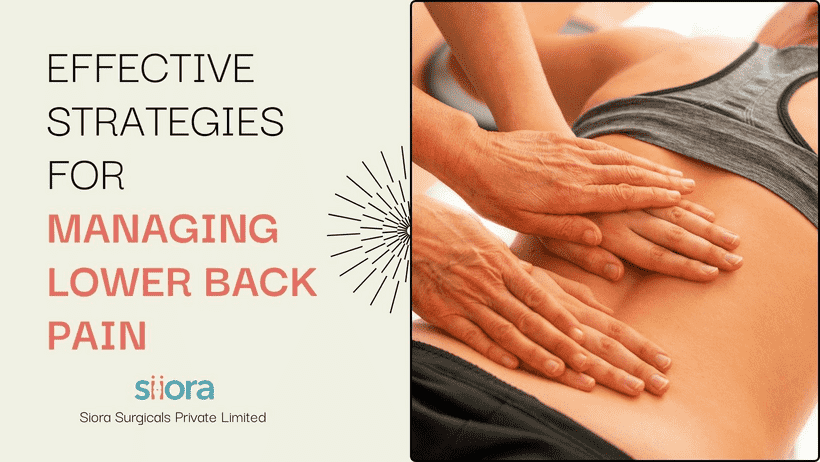Lower back pain has become a common problem in adults, and the changing lifestyle is among the commonest reasons for that. Persistent lower back pain could be the cause of spinal problems, and if the problem becomes serious, surgery may be required.

Orthopedic surgeries do require implants like Herbert screws & locking plates, but in the case of spinal surgeries, special Spine Implants depending upon the condition are used.
To prevent making the condition worse, it is advised to consult the doctor in time and take measures to manage back pain. In this post, we will discuss some of the important and workable ways to manage lower back pain. Let us have a look at what those ways are.
Tips to Improve Lower Back Pain
Maintain an Active Lifestyle
As we’ve said above, changing lifestyle is one of the biggest reasons for lower back pain in most individuals. Poor body posture while sitting or sleeping, a sedentary lifestyle, and stress are among the reasons for back pain. So, the first and most important way to improve back pain or even prevent it from reoccurring is to maintain an active lifestyle.
For that, you need to maintain your workout routine, and that is only possible when you come out of your comfort zone. Depending upon your condition, it is advised to make walking a habit. If the pain is mild, you can also do cycling regularly. But to achieve results, you are required to be consistent with what you are doing.
Do Back Stretches
Making it a routine to do back stretches also helps improve lower back pain while improving the strength and flexibility of muscles. Here, we are talking about simple stretches that you can do at home. There is no need to join a gym for that. For this, you can consult a physiotherapist as he could guide you with that. Again, it is advised to be regular with the exercises.
Some effective stretches include the cat-cow stretch, which helps in gently stretching the spine, and the child’s pose, which relieves tension in the lower back. Regularly performing these stretches can alleviate stiffness and improve the range of motion.
Heat and Cold Therapy
This technique is better for improving moderate to severe pain along with swelling. But you must remember that using heat or cold therapy can only provide temporary relief. It is also known to be a great way of relieving back pain caused by sore muscles. For heat therapy, you can either take a warm bath, use a heat pack on the affected area, or place a bottle filled with hot water.
When it comes to cold therapy, one can either use a cold pack or ice wrapped in a towel. Remember, do not apply ice directly on the skin as it may result in cold burns. Alternating between heat and cold therapy can also be beneficial, as it helps to reduce inflammation and improve blood flow to the affected area.
Over-The-Counter Medicines
When the pain is severe or it does not improve with the above-mentioned ways, it is advised to take over-the-counter medicines as they can provide quick relief. You can also use topical ointments in the form of cream or gel. If the pain is persistent or still does not improve, immediately consult a specialist.
Common over-the-counter pain relievers include ibuprofen and acetaminophen, which help in reducing inflammation and pain. However, these should be used as directed and not relied upon for long-term management without medical advice.
Lifestyle Adjustments to Prevent Lower Back Pain
Improve Your Posture
Maintaining good posture is crucial in preventing and managing lower back pain. Ensure that your workspace is ergonomically designed, with your chair providing adequate lumbar support and your computer screen at eye level. Avoid slouching and make a conscious effort to sit and stand up straight.
Healthy Diet and Weight Management
A balanced diet rich in calcium and vitamin D is essential for bone health while maintaining a healthy weight reduces strain on your lower back. Excess weight, especially around the abdomen, can pull the pelvis forward and strain the lower back muscles.
Stay Hydrated
Hydration is often overlooked but is vital for maintaining the elasticity of soft tissues and the fluidity of joints. Drinking enough water helps in keeping the spinal discs hydrated, reducing the risk of back pain.
Regular Physical Activity
Engage in regular physical activity that strengthens the core muscles. Strong core muscles provide better support for the spine, reducing the risk of back injuries. Activities like swimming, walking, and low-impact aerobics are excellent choices for maintaining back health.
Mindfulness and Stress Management
Stress can contribute to muscle tension and exacerbate back pain. Practices such as mindfulness, meditation, and deep-breathing exercises can help in managing stress levels, and promoting relaxation and overall well-being.
Seek Professional Help When Needed
If self-care measures do not alleviate your back pain, it is important to seek professional help. A physical therapist can provide personalized exercises and treatments to address your specific condition. In some cases, chiropractic care or acupuncture may also offer relief.
Conclusion
Managing lower back pain involves a combination of lifestyle changes, physical activity, and professional guidance. By maintaining an active lifestyle, practising regular stretching, using heat and cold therapy, and making necessary lifestyle adjustments, you can significantly reduce the impact of lower back pain on your daily life. Remember, if the pain persists, consulting a healthcare professional is crucial to prevent further complications.
About writer
Siora Surgicals Pvt. Ltd. is a leader in the orthopedic implant manufacturing industry that has been operating for over 3 decades. It has hundreds of distributors in over 50 countries and is also looking to be counted among the top Orthopaedic Device Companies in Lithuania.
The company holds expertise in producing an extensive range of trauma implants using medical-grade stainless steel and titanium.


